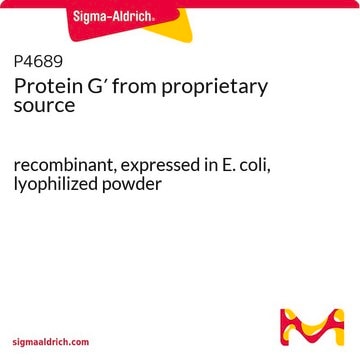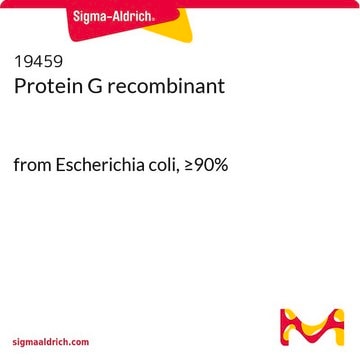539303
Protein G, Recombinant, E. coli
Synonym(s):
Recombinant Protein G
Sign Into View Organizational & Contract Pricing
All Photos(1)
About This Item
UNSPSC Code:
41116133
NACRES:
NA.41
Recommended Products
Assay
≥98% (SDS-PAGE)
Quality Level
form
lyophilized solid
manufacturer/tradename
Calbiochem®
storage condition
OK to freeze
solubility
aqueous buffer: 5 mg/mL
water: 5 mg/mL
shipped in
ambient
storage temp.
−20°C
General description
1 mg Protein G, Recombinant, E. coli binds 5 mg human IgG at pH 5-6.
Packaging
Glass Bottle
Warning
Toxicity: Standard Handling (A)
Reconstitution
Following reconstitution, aliquot and freeze (-20°C). Avoid freeze/thaw cycles. Stock solutions are stable for up to 6 months at -20°C.
Other Notes
Fahnestock, 1987. Trends in Biotechnology5, 79.
Fahnestock, et al. 1986. J. Bacter167, 870.
Bjørck, L. and Kronvall, G. 1984. J. Immunol.133, 969.
Fahnestock, et al. 1986. J. Bacter167, 870.
Bjørck, L. and Kronvall, G. 1984. J. Immunol.133, 969.
Legal Information
CALBIOCHEM is a registered trademark of Merck KGaA, Darmstadt, Germany
Storage Class Code
11 - Combustible Solids
WGK
WGK 1
Flash Point(F)
Not applicable
Flash Point(C)
Not applicable
Certificates of Analysis (COA)
Search for Certificates of Analysis (COA) by entering the products Lot/Batch Number. Lot and Batch Numbers can be found on a product’s label following the words ‘Lot’ or ‘Batch’.
Already Own This Product?
Find documentation for the products that you have recently purchased in the Document Library.
Customers Also Viewed
S R Fahnestock et al.
Journal of bacteriology, 167(3), 870-880 (1986-09-01)
The gene (spg) for an immunoglobulin G (IgG)-binding protein from a Streptococcus clinical isolate of Lancefield group G was cloned and expressed in Escherichia coli. The complete nucleotide sequence of the gene and 5'-flanking sequences was determined. The DNA sequence
L Björck et al.
Journal of immunology (Baltimore, Md. : 1950), 133(2), 969-974 (1984-08-01)
Protein G, a bacterial cell wall protein with affinity for immunoglobulin G (IgG), has been isolated from a human group G streptococcal strain (G148). Bacterial surface proteins were solubilized by enzymatic digestion with papain. Protein G was isolated by sequential
Our team of scientists has experience in all areas of research including Life Science, Material Science, Chemical Synthesis, Chromatography, Analytical and many others.
Contact Technical Service













